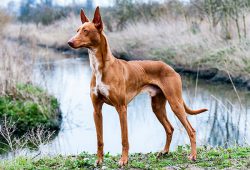The Pharaoh Hound is a Maltese breed of dog and the national dog of [wiki base=”EN”]Malta[/wiki]. In Maltese it is called Kelb tal-Fenek, which means “rabbit dog”. It is traditionally used for hunting rabbit in the Maltese Islands.
Based on DNA analysis, the breed has no link with Ancient Egypt. However, a popular myth holds that the breed is descended from the Tesem, one of the ancient Egyptian hunting dogs. Some believe that there are similarities between the breed and images of dogs found on the walls of ancient Egyptian tombs. This myth proposes that the Pharaoh Hound was brought by the Phoenicians to Malta, where it has existed for over 2,000 years.
Appearance
At first glance, the Pharaoh Hound appears both graceful and elegant as well as powerful and athletic. Its build is one of strength without bulkiness or excessive musculature. Its head is elegant without being fine or extreme. The skull resembles a blunt wedge, and is long and chiseled with only a slight stop and a snout of good length. Its eyes are oval with a keen, alert, and intelligent expression. Their eyes are commonly amber-colored. It has a long, lean, and muscular neck that is slightly arched. It has a deep chest that extends down to the elbows and a moderate tuck up. Its shoulders are long and well laid back. Its front legs are long and straight. The back legs are moderately angled, parallel to each other, and must be balanced with the forelegs. It has a long, fine, straight tail that reaches down to a bit below the point of the hocks, and has a whip-like shape. The tail is carried down when relaxed. When the dog is in motion or is excited, the tail is carried up; either level with, or loosely curled above, the back. Its dewclaws may be removed. The Pharaoh Hound’s ears are very large and point upward when alert. They usually come in tan or chestnut colors. A white tail-tip is admired. Most commonly seen is any solid white spot on their neck, back, or shoulders. Mainly seen on the back or sides of the dog.
Pharaoh Hounds tend to weigh up to 45-55 pounds on average. Weight depends on the sex of the dog, or its eating habits. Male Pharaoh Hounds are normally considered larger than the females. Males usually are 23-25″, while females are 21-24″. Size and weight also relate to the amount of exercise it receives.
Care
The Pharaoh Hound is independent-minded, highly intelligent, and occasionally stubborn, yet very trainable when positive methods are used. It is a very sensitive breed and responds poorly to compulsory training methods and to being physically punished. Pharaohs can succeed in competition obedience, but they do not take to it naturally as many breeds that were bred to work alongside people. Pharaohs were bred to hunt and think for themselves, and they have retained this trait. They tire/bore easily with repetitive commands, therefore it is the trainer’s job to ensure that their training remains interesting and positive in nature.
They have sensitive skin, and shampoo (canine or human) may cause allergic reactions; therefore, it is best to wash them with a gentle dog shampoo, and not a human shampoo (as humans require a different pH than dogs). Grooming Pharaohs is as easy as a quick rub with a hound glove or a damp cloth. They are clean dogs, shed very little, and have no noticeable odour, except when wet or when they’ve been outside. But their odour quickly returns to normal.
Health
Pharaoh hounds, being somewhat uncommon outside of the Maltese Islands of Malta and Gozo, and because they are not profitable for commercial breeding, have not been subjected to as much irresponsible breeding as some more popular breeds. Breeders try hard to prevent hereditary diseases from entering the gene pool and according to the American breed club, Pharaohs are virtually free from genetic diseases. Reputable breeders continue to test their breeding stock for genetic conditions such as [wiki title=”Hip_dysplasia_(canine)” base=”EN”]hip dysplasia[/wiki], luxating patellas, and myriad eye conditions just to ensure that these disorders do not become a problem. Reputable breeders should be able to show documentation of health screening performed on their breeding dogs. Note that Pharaohs, like most sighthounds, are sensitive to barbiturate anaesthetics. Their ears are thin and prone to frostbite when in cold climates.
Life expectancy is about 12 to 14 years.
Pharaoh Hound. (2017, July 11). In Wikipedia, The Free Encyclopedia. Retrieved from https://en.wikipedia.org/w/index.php?title=Pharaoh_Hound&oldid=790071512


